The Bassett Brothers Camping Operation
Copyright 2014 by Robert V. Goss. All rights reserved.
No part of this work may be reproduced or utilized in any form
by any means, electronic or mechanical, including photocopying,
recording or by an information storage and retrieval system
without permission in writing from the author

The western entrance has always been a natural point of entry to Yellowstone since the early trapping days and no doubt for Native Americans in the pre-EuroAmerican contact era. Admittedly, for 6-8 months of the year the area is heavily laden with snow, but the rest of the year access along the Madison River and the relatively benign topography is very inviting. However, the area is difficult to get to from any major population center. There are no navigable rivers close to the area such as there is at the comparatively snow-free north entrance. With the gold rush in the early 1860’s and steamboats plying the Missouri River as far as Ft. Benton, MT and Bozeman being only 70 miles from the park, stagecoach roads quickly developed and most travelers and explorers used the north entrance. Due to the remoteness of the west entrance, a formal town would not be established there until 1907 when in the fall the Yellowstone Branch Line reached the current site of West Yellowstone from St. Anthony, ID.
|
Yellowstone MT Depot ca1912
Detroit Photographic Co. Post Card 70996
|
In 1870, the Utah and Northern RR was organized primarily to tap into the gold mines and expanding markets in Montana. The Union and Central Pacific RRs had just completed their transcontinental railroad the previous year and needed to develop markets for the new line. Construction began in 1871 on a narrow gauge rail line from Brigham City, UT to Butte MT. Progress was slow and the line reached Franklin ID in early 1874 when the Panic of 1873 brought rail construction in the Rockies to a standstill for several years. The Utah Northern RR was reorganized in 1878 with backing by the Union Pacific RR and was renamed the Utah & Northern RR. Progress became more rapid and on September 1, 1879 the railroad reached Beaver Canon, less than 20 miles from the Montana state line.
|
 |
|
Beaver Canon, had been established about 1872 along the main stage and freight road from Utah to the mining communities of Montana. Harsh winter weather and lack of materials stalled the railroad’s progress once again and Beaver Canon was the rail terminus until early March of 1880 when the U&NRR rail lines reached the Montana border. At that point, at an elevation of almost 6800 feet, the town of Monida was established, combining the name of MON-tana and IDA-ho. The line reached Garrison, near Butte, on December 26, 1881.
Click Here to view my Monida & Beaver Canyon Page.Beaver Canyon 1885
Photo Courtesy of OurGenerationsAncestors.org
|
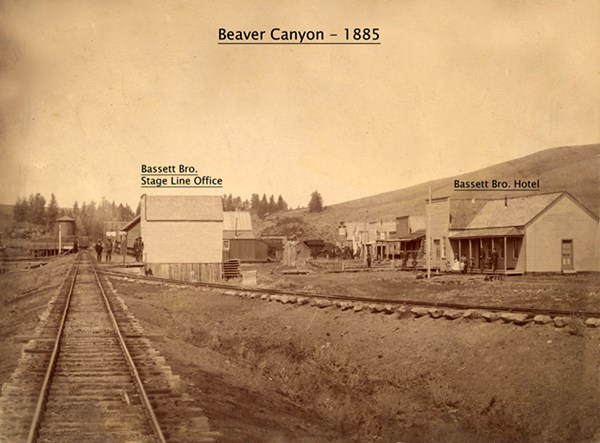 |
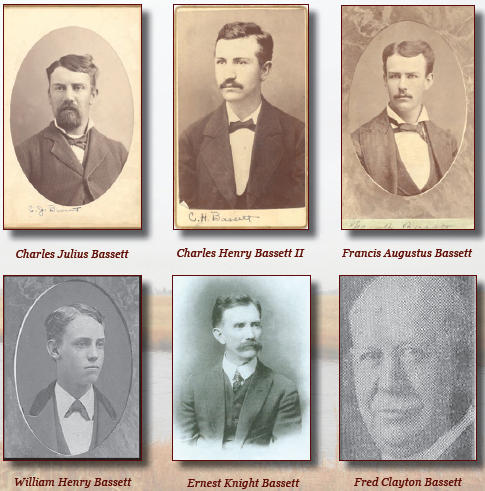 |
The Bassett family was headed by father Charles Henry Bassett of New York. By 1845 Mr. Bassett was living in the Mormon community in Navoo, Illinois, where he married Permilia Mindwell Dayton. Driven out of Navoo by angry anti-Mormon mobs, they Bassetts settled in Iowa before moving to Salt Lake City in 1852 to join their fellow Mormons. The following year Charles Henry Bassett married Mary Elizabeth Knight. Ernest and William Henry were sons of that marriage, while Charles Henry II, Charles Julius, Frank, and Fred were sons of Permilia. It has been reported that Charles Henry Bassett sired 22-34 children from five wives. By the late 1870s most of the Bassett Brothers had moved north to southeastern Idaho.
Photo Courtesy of OurGenerationsAncestors.org
|
| In 1879 mail service was established from Virginia City, Montana to the Lower Geyser Basin of Yellowstone Park. George W. Marshall was the first mail carrier and on September 13, 1880 a mail station was established in conjunction with his primitive Marshall Hotel near the junction of the Firehole River and Nez Perce Creek (approximate location of today’s Nez Perce Picnic area). It was known as the Firehole Post Office and George’s wife Sarah was postmistress for the first two years. Sometime that fall or winter brothers William Henry and Ernest Bassett began working as mail carriers on the route from Virginia City to Firehole. |
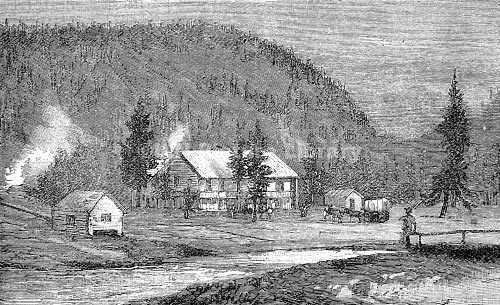
Woodcut illustration of the Firehole Hotel in 1888. |
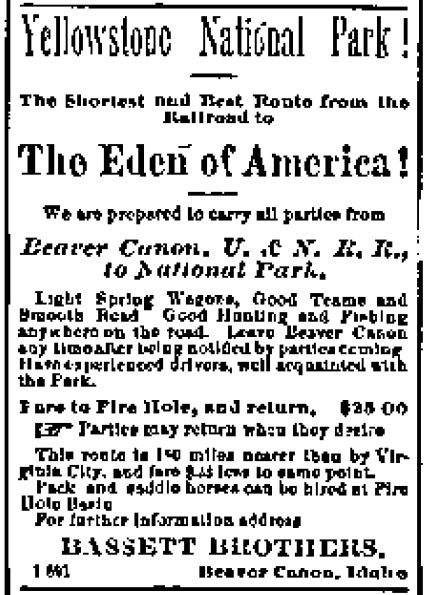
Salt Lake Tribune
Sept. 9, 1881
|
The Bassett Brothers started a stage and camping operation by at least the summer of 1881 that conveyed tourists from the rail stop at Beaver Canon to the Firehole and Yellowstone Park. William Henry Bassett (W.H. Bassett) and Charles Julius Bassett (C.J. Bassett) seem to have been the prime movers of the operation. Other brothers involved over the years were Charles Henry Bassett II, Fred C. Bassett, Frank A. Bassett, and Ernest Bassett.
A newspaper article from the Salt Lake Tribune in August of 1881 noted that,
“Travelers can take the comfortable cars of the Utah & Northern in Ogden for Beaver Canyon, where connection can be made with Bassett Bros. through line to the Yellowstone. This line is composed of covered light spring wagons with the best of teams, and passes over one of the best roads in the country. This route is 150 miles shorter than by way of Virginia [Virginia City, Mt.] and the fare is $28 less than by that place. Experienced drivers are furnished and passengers are put through in quick time.”
Another newspaper advertisement from August 1881 proclaimed that the Bassett Brothers had “The Shortest and Best Route from the Railroad to The Eden of America. We are prepared to carry all parties from Beaver Canyon, U&N.R.R., to National Park.”
Fare was $25.00 for a round trip to the Fire Hole.
|
|
In the summer of 1882 Mary Bradshaw Richards and her husband Jesse Richards traveled from their home in New York City to Yellowstone Park and took advantage of the services of the Bassetts. The following excerpt offers a glimpse of the Bassett operation:
"Our outfit (two persons) consisted of a wall tent, blankets, buffalo skins, axe, hatchet, nails, ropes, hammer and wheel grease; flour, sugar, lard, ham, eggs packed in oats, canned meats, fruits and jellies; a long-tailed frying pan, bake kettle, coffee pot, tin plates, cups and spoons, knives and forks; a capital driver, an accomplished cook, two large balky horses and lastly the all important spring wagons, canvas-covered, large, strong, rather stiff in the joints, but possessing a fitness for its purpose which we soon learned to appreciate. This outfit cost us eighteen dollars per day."
"The distance from Beaver Canyon to Lower Geyser basin is about one hundred and ten miles. We are to camp three nights on the route . . . Inside our new home [tent] is our furniture, viz.: a bed of blankets folded on a rubber sheet, our hamper for a table, a wagon seat for a sofa, a candle set in a bottle for an electric light, a tin wash basin, soap and towels on a pile of grass for a toilet room - only these and nothing more . . . A campfire, now having finished its blazing, is at work baking bread and boiling coffee and broiling pine-hen and ham. How hungry we are!"
[From Camping Out in the Yellowstone - 1882, by Mary Bradshaw Richards, Univ. of Utah Press, 1994]
|
 |
In August of 1882 an Ogden newspaper noted that,
"The Bassett Bros. are now making extensive preparations to carry passengers from this point to the National Park, this summer, and we have no doubt but their line will be extensively patronized by pleasure-seekers who wish to take the shortest route and best road to see the sights of the Yellowstone." Two years later the paper reported that business for the Bassett Brothers had doubled and that overnight accommodations had been established along the route for travelers.
Left: Salt Lake Daily Tribune, 7-30-1882
Right: Ogden Standard Examiner, 6-7-1883
|
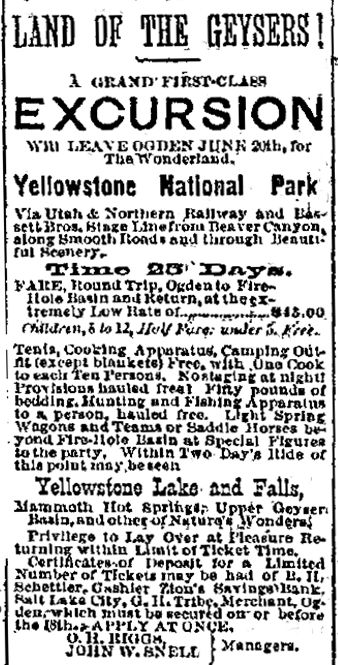 |
|
Excerpts from C.R. Savage’s trip to Wonderland on the Bassett Brothers route in 1884.
“The proper thing to do is to go by rail to Beaver Canon, and go by way of Bassett's stage line, this will land you in the park in three days . . . The best time to visit this Wonderland is from the first of August to the 15th of September, although hundreds go in from the first of June, but the flies and mosquitoes are very troublesome in July . . . The road from Beaver Canon passes over a series of low, rolling hills, the northern edge of the great Snake river valley . . . To the right the towering peaks of the three Tetons loom up above the horizon . . . Grass and water are abundant, the mountains of the Rocky range on our left furnish any number of streams of beautiful water, in which sport thousands of brook trout . . . [We] reach Rea's ranch, the night station of the Bassett line. Of all the lovely spots to invite the tourist to linger in, none ever seemed so inviting as this one to me. The smooth glassy river [Henry's Fork of Snake River] swarms with trout . . . The log hut is embellished with the skins of grizzlies, elk and other animals. This is a good spot to let your own camping outfit have a rest and try the repast served up by Mrs. Bassett in the dinner tent. Trout and venison are the staples, and no stint.”
|
Photo courtesy of
Wonderland; or, Twelve Weeks in and out of the United States, by Edward S. Parkinson, 1894.
Text version of book available at American Memory |
|
Charles Roscoe (C.R.) Savage (August 16, 1832 – February 4, 1909) was a British-born landscape and portrait photographer who produced images of the American West. He is best known for his 1869 photographs of the linking of the first transcontinental railroad. Savage photographed scenic areas of the West, including Yellowstone National Park, Zion National Park, and created many images documenting the growth of Utah towns and cities. Savage visited Yellowstone in 1875 and 1884 and is known to have published at least 19 stereoviews of Yellowstone Park.
|
|
Bassett Brothers Letterhead in 1885
Courtesy YNP Archives.
|
By 1885 the company was using the name Yellowstone National Park Stage Line. In a letter to a prospective client, they quoted a rate of $25 per person to take a nine-day trip via the Upper Geyser Basin, Yellowstone Lake, past Sulfur Mountain to the Grand Canyon, over Mary’s Lake, north to Mammoth Hot Springs, and return to the West entrance. Clients saved five dollars if the two-day Mammoth leg was skipped. The Bassett Bros. never received a formal lease for their operation in Yellowstone, but operated on yearly permits, which were not guaranteed from year to year.
|
Changes in the world of accommodations in Yellowstone were slowly wrought beginning in 1883 when the North Pacific RR’s spur line from Livingston reached Cinnabar Mt near the north entrance to the park. The Yellowstone Park Improvement Co. was formed with the intention of building a series of hotels throughout the park. They opened the National Hotel at Mammoth in early August and tent hotels sprung up at Old Faithful, Lake, and Canyon. But financial and other difficulties plagued the company and they went into bankruptcy in 1885. The NPRR took over the assets and reorganized the company as the Yellowstone Park Association in 1886. By 1891, with stable financial backing, hotels were in operation at Norris, Canyon, Lake, and Fountain Flats.
With this changing cultural landscape, the Bassett Bros. mostly got out of the camping business in 1886 and perhaps seeing the hotel crowd as more lucrative, concentrated their efforts on stage transportation for tourists to the various park hotels. The Salt Lake Tribune of June 8, 1892 noted that, “The Bassett Brothers have men and trains on the road putting it in fine condition for travel, and they hope to take many into the park this season. It is a delightful ride from this point into the park, there being fine scenery all the way, and it is a fine road to travel over. The Bassett Brothers line will be fully in operation in a few days.”
|
Collage of the primary hotels in Yellowstone by 1899.
Photo from 1899 brochure "Where Gush the Geysers"
by the Union Pacific RR
|
|
1902 brochure cover from Monida & Yellowstone Stage Co.
|
In the early 1890’s the company moved the head of their operations from Beaver to Monida and in 1895 began operating as the Union Pacific Stage Lines with C.J. Bassett as proprietor. They were the only transportation company to operate through the west entrance from 1881 until 1898 when they were refused a permit to operate in the park. A new company, the Monida & Yellowstone Stage Company was granted the sole concession to transport visitors through the west entrance into Yellowstone. Formed in 1898 by Frank J. Haynes (park photographer since 1884) and Wm. H. Humphrey, they received a 10-year lease from Interior, something the Bassets could never obtain. The new company provided stage service from the UPRR depot at Monida to the park, using red Concord stages, and became known as the 'Red Line`. The route from Monida passed through Centennial Valley, past Henry`s Lake, over Targhee Pass, with an overnight stop at Dwelle`s Inn. This was a part of Harry Dwelle`s Madison Fork Ranch that was located about 5 miles west of the park border. Fountain Hotel was reached around noon the following day. |
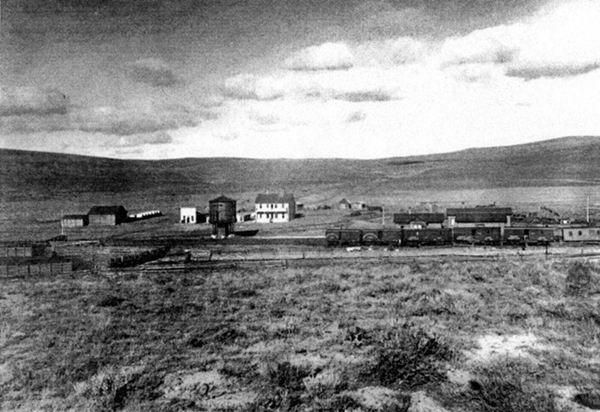
Frank J. Haynes photo of Monida in 1898.
Photo courtesy Montana Historical Society |
|
Click photo to view article from the Boise Idaho Statesman, 11-27-1918.
|
After that time the Bassett brothers spread out into various separate occupations. Charles Julius Bassett, who had become the Idaho Secretary of State just after the turn of the century, died on November 26, 1918 in Boise, Idaho at age 67. William Henry Bassett, former postmaster in Lago, Idaho, died in a car accident on December 29, 1929 at age 71.
|
Click photo to view article from the Pocatello Tribune, 12-28-1929.
|
Much of the information from this page was drawn from the
Bassett Bros. Transportation page from my old Geocities website.
Click Here to view that page (courtesy Archive.org) for more detailed info on the Bassett family and operations. |
Copyright 2014 by Robert V. Goss. All rights reserved.
No part of this work may be reproduced or utilized in any form
by any means, electronic or mechanical, including photocopying,
recording or by an information storage and retrieval system
without permission in writing from the author
|